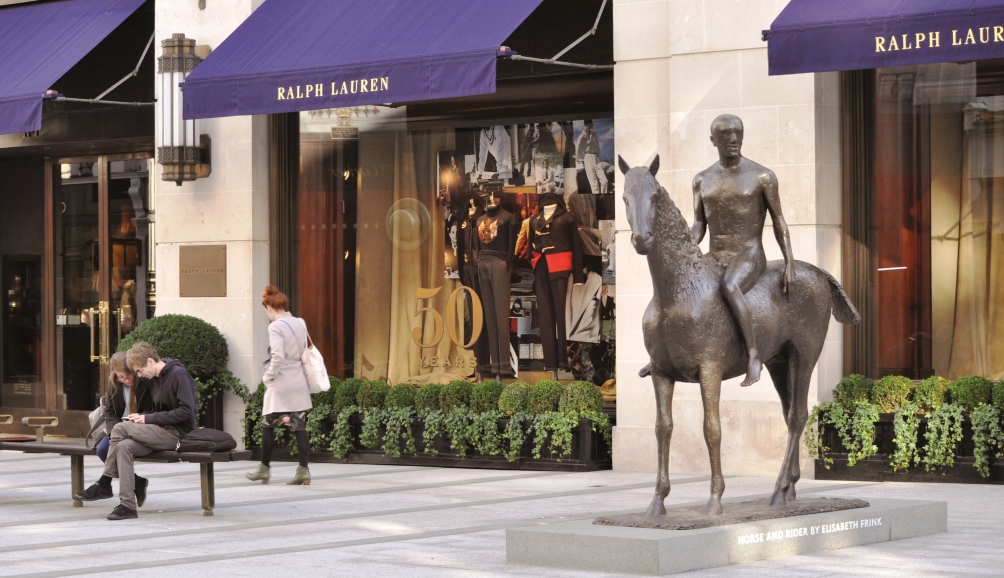Set within London, England’s historic Mayfair area, the name “Bond Street” is synonymous with British fashion, luxury, style, and world class art and antiques. But in recent years the quality of the public realm in Bond Street had fallen out of step with the caliber of its buildings, retailers and international reputation.
To address these issues, the Westminster City Council and the New West End Company (NWEC) worked in partnership with Transport for London (TfL) to deliver an ambitious plan to reinvigorate Bond Street’s public realm. FM Conway-WSP—with support from urban designers Publica and traffic consultants Norman Rourke Pryme—were commissioned to develop an elegant and unified design that prioritizes pedestrians, manages traffic and parking, improves the public space and re-establishes Bond Street as a world-class destination.
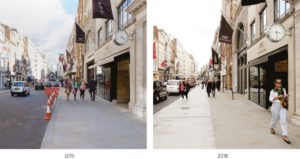 The design for Bond Street was developed from a detailed audit and analysis of both the street and the wider neighbourhood. The Publica team mapped and documented existing street uses, routes, character, connections, material, architectural and spatial conditions, while anticipating the impact of new patterns of movement across the district such as the new Bond Street railway station. The survey included an in-depth analysis of the wider development context, history, improvements by neighboring landowners and developers, and identified opportunities for enhancements to the street.
The design for Bond Street was developed from a detailed audit and analysis of both the street and the wider neighbourhood. The Publica team mapped and documented existing street uses, routes, character, connections, material, architectural and spatial conditions, while anticipating the impact of new patterns of movement across the district such as the new Bond Street railway station. The survey included an in-depth analysis of the wider development context, history, improvements by neighboring landowners and developers, and identified opportunities for enhancements to the street.
Publica then proposed a holistic concept design, followed by landscape and urban designs integrating with the engineering teams. NRP provided specialist traffic modelling and guidance on loading/parking arrangements. WSP managed the project and led the engineering design through to construction, also working to ensure substantial communication and engagement with local people. FM Conway provided early contractor involvement during the design process and then delivered the scheme to a high standard. WCC officers, NWEC, Publica, WSP and FMC guarded quality throughout the project ensuring that a public realm of the highest standard was delivered in line with WCC’s and funders’ expectations.
Building an inclusive public realm
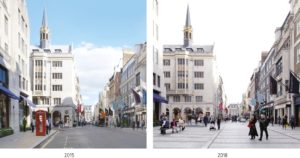 The redesign of Bond Street supports the goals of the Mayor of London’s Healthy Streets program, which aims to improve the local environment by providing more space for walking and cycling and improved spaces where people can interact. The project prioritizes pedestrians, residents and visitors alike, with widened pathways and improved accessibility, and also considered cycling in its design through improved signage, route legibility, and the maintenance of cycling infrastructure.
The redesign of Bond Street supports the goals of the Mayor of London’s Healthy Streets program, which aims to improve the local environment by providing more space for walking and cycling and improved spaces where people can interact. The project prioritizes pedestrians, residents and visitors alike, with widened pathways and improved accessibility, and also considered cycling in its design through improved signage, route legibility, and the maintenance of cycling infrastructure.
The project promotes environmental sustainability, personal as well as social well-being through new tree planting, public seating, improved settings for public art, commemoration, use of hard-wearing natural materials and the creation of new space intended for social interaction, cultural life and leisure.
From its inception, the project’s design aspirations were developed in dialogue with the local community – not just the high-end retailers, but employees, visitors and local residents’ groups. The project has delivered a safer, more accessible public realm to better meet the needs of people of all ages, abilities and backgrounds. New bespoke furniture, greenery and lighting provide a public realm for all to enjoy. The positioning of features respects the requirements – in terms of loading, parking and access – of residential dwellings accessed off – or just off – Bond Street.
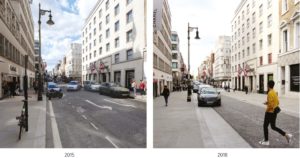 The design includes a carefully selected high quality materials palette—York Stone, Portuguese silver granite and green and black stone paving—along with streamlined road signs and markings to create a calmer streetscape.
The design includes a carefully selected high quality materials palette—York Stone, Portuguese silver granite and green and black stone paving—along with streamlined road signs and markings to create a calmer streetscape.
The design flexibly responds to the different functions and character areas along the street whilst balancing the needs of pedestrians, bicycles, cars, taxis and service vehicles.
Wider pathways and improved crossings have been provided in anticipation of increased footfall which will come with the opening of the new Elizabeth line. New specially designed benches, new greenery and lighting, as well as improved settings for art and historic architecture provide a public realm for all to enjoy.
The project has improved both visitors’ and the local community’s ability to promenade, enjoy a world renowned street and several key pieces of public art – Elizabeth Frink’s Horse and Rider sculpture was relocated to a prominent position on the street with a plaque providing additional information about the artwork, unveiled as part of Mayfair Art Weekend in June 2018; Henry Moore’s Time and Life screen is also now illuminated by night, and all new lighting creates continuity along the street harmonizing with retail displays, modern and heritage buildings.
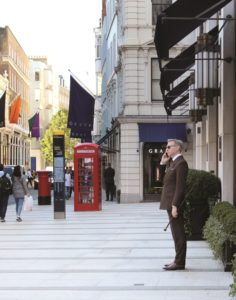 The project exemplifies a successful public realm regeneration project, exemplifying best in class civic space on a complex and high-profile site, realized through a multi-disciplinary approach and extensive partnership collaboration.
The project exemplifies a successful public realm regeneration project, exemplifying best in class civic space on a complex and high-profile site, realized through a multi-disciplinary approach and extensive partnership collaboration.
The Bond Street public realm improvements were developed through the collective expertise of various stakeholders, all of whom contributed to delivering a design which balances the needs of different transport modes, celebrates the historic buildings and anticipates future change.
In all, the project not only revitalizes Bond Street as a location for business, shopping, and commerce, as well as a key city walking route – the project has delivered the street as a destination in its own right, a place to pause, enjoy and experience a prime location for cultural experience and public life, the unifying street of this historic mixed-use neighbourhood.
All photos courtesy of Publica.

